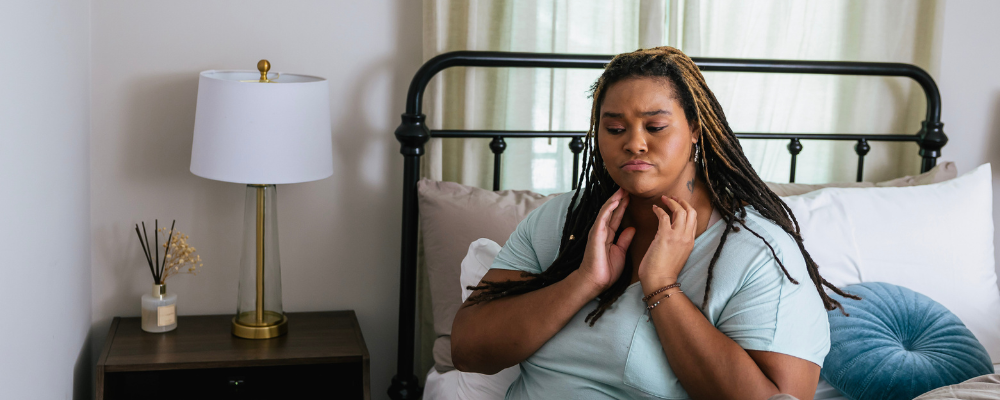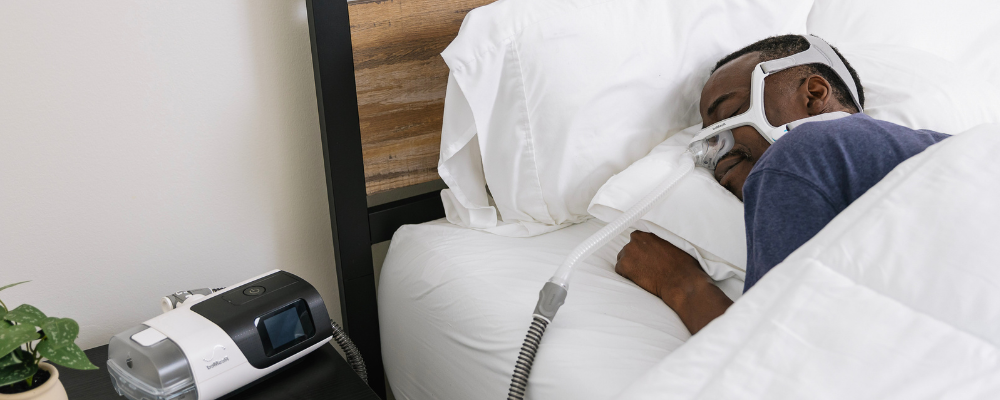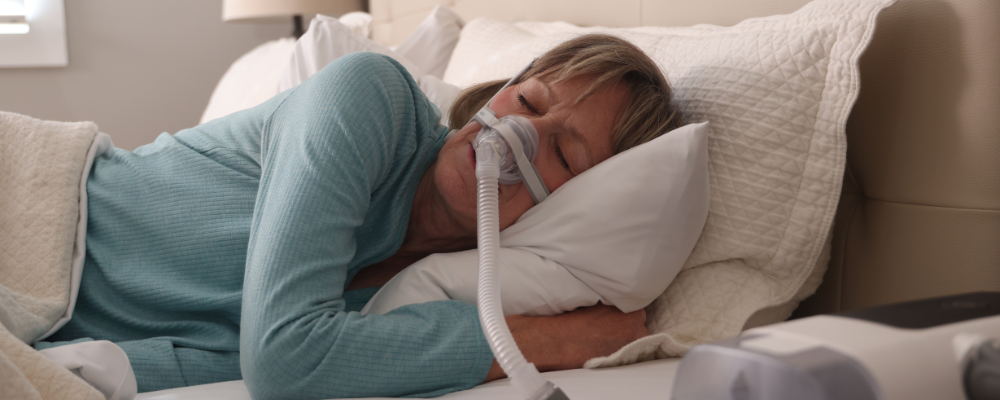Obstructive sleep apnea (OSA) occurs when a physical blockage in your airway stops you from breathing while sleeping. While there are several risk factors that put you at risk for developing OSA, could your neck size be one? We’ve teamed up with Aeroflow Sleep Science Advisor Dr. Carleara Weiss to bring you the answer!
Key Takeaways
-
Neck circumference can be a predictor for obstructive sleep apnea (OSA).
-
However, not all patients with obstructive sleep apnea have larger necks.
-
Losing weight can help reduce OSA-related symptoms, but it will not provide a complete cure.
-
The most common treatment for OSA is Continuous Positive Airway Pressure (CPAP).

Neck circumference can be a predictor for obstructive sleep apnea.
There are a variety of factors that may put you at risk for developing obstructive sleep apnea (or OSA). According to the Mayo Clinic, some of the biggest risk factors for developing obstructive sleep apnea include: obesity, being male, being older, having a family history of sleep disorders, suffering from chronic nasal congestion, having pre-existing medical conditions like congestive heart failure or high blood pressure, and the size of your neck.
More specifically, according to the American Academy of Sleep Medicine, if you have a neck circumference that’s greater than 16 inches for women and 17 inches for men, your neck size can significantly increase your risk of OSA.
Furthermore, some physicians even use a screening tool called the ‘STOP-Bang Questionnaire’ to diagnose OSA. This questionnaire considers anthropometric measurements like body mass index (BMI) and, you guessed it, neck circumference.
So, how exactly does a large neck lead to an increased risk for obstructive sleep apnea?
Individuals with large necks tend to have excess fat deposits near their upper airway, which can lead to a narrowed airway and increase the likelihood of an obstruction or blockage that disrupts normal airflow.
However, not all patients with obstructive sleep apnea have larger necks.
Yes, you can develop sleep apnea without having a large neck. Sleep apnea patients come in all shapes and sizes; even individuals who have a healthy body mass index can also have sleep apnea.
While neck size is a risk factor for OSA, as we previously mentioned, there are a variety of factors that can contribute to this condition. Also keep in mind that other anatomical traits aside from neck circumference, such as the size of the upper airways, may increase the risk in Asian and African Americans.
If you think you may have sleep apnea, it is best to reach out to your healthcare provider. They will likely recommend a sleep study, or polysomnography, to determine if you have a sleep disorder or not.
Losing weight can help reduce OSA-related symptoms, but it will not provide a complete cure.
Weight loss can help reduce the size of your neck. So, will reducing your neck fat help with sleep apnea? Yes, losing body fat can in fact help reduce OSA symptoms, like daytime sleepiness.
However, weight loss will unfortunately not provide a complete cure. Despite this, losing weight can help reduce side effects of obesity like heart attack, cardiovascular disease, metabolic syndrome, and hypertension.
The most common treatment for OSA is Continuous Positive Airway Pressure (CPAP).
One of the most popular treatment options is a form of positive airway pressure called continuous positive airway pressure (or CPAP). CPAP works by delivering pressurized air through a machine and mask to help keep your airways open while sleeping. There are a variety of styles and sizes of CPAP masks, which makes it easy to find a fit that’s most comfortable for you.
Obstructive sleep apnea can also be treated with oral appliances, surgery, and/or lifestyle changes, depending on its severity. It’s best to speak with your healthcare provider to determine which treatment plan will work best for you.
At Aeroflow Sleep, we specialize in providing PAP supplies through insurance. We work with your insurance provider and doctor to help ensure you get the CPAP equipment you need covered through your insurance. To see if you qualify, check your eligibility below!
References
Adult Obstructive Sleep Apnea Task Force of the American Academy of Sleep Medicine. “Clinical Guideline for the Evaluation, Management and Long-Term Care of Obstructive Sleep Apnea in Adults | Journal of Clinical Sleep Medicine.” Journal of Clinical Sleep Medicine, Journal of Clinical Sleep Medicine, 15 June 2009, jcsm.aasm.org/doi/10.5664/jcsm.27497.
Johnson, D. A., Guo, N., Rueschman, M., Wang, R., Wilson, J. G., & Redline, S. (2018). Prevalence and correlates of obstructive sleep apnea among African Americans: the Jackson Heart Sleep Study. Sleep, 41(10), zsy154. https://doi.org/10.1093/sleep/zsy154
Mirrakhimov, A. E., Sooronbaev, T., & Mirrakhimov, E. M. (2013). Prevalence of obstructive sleep apnea in Asian adults: a systematic review of the literature. BMC pulmonary medicine, 13, 10. https://doi.org/10.1186/1471-2466-13-10
Mayo Clinic Staff. “Sleep Apnea.” Mayo Clinic, Mayo Foundation for Medical Education and Research, 6 Apr. 2023, www.mayoclinic.org/diseases-conditions/sleep-apnea/symptoms-causes/syc-20377631.
“What Is the Correlation between Neck Size and Sleep Apnea?” ResMed, ResMed, www.resmed.com/en-us/sleep-apnea/sleep-blog/what-is-the-correlation-between-neck-size-and-sleep-apnea/. Accessed 2 Jan. 2025.








